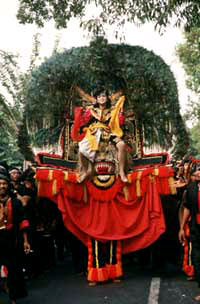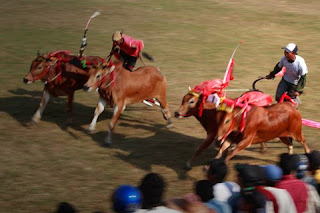Wayang topeng. Masked dance was also popular at the eastern Javanese courts (c. 1000-1400) and may be related to ancient animistic masked dance seen throughout the Pacific islands. Later, Indian dance style was assimilated, and sometime after the 15th century at the earliest, the Pandji story was dramatized. This is wayang topeng, widely performed as both a sophisticated and a folk art throughout Indonesia. Unlike the large-scale unmasked dance-drama, topeng dance focusses on interpreting character through solo dance.

Wayang Topeng
Wayang orang.
Java's spectacular dance-drama, wayang orang, grew out of the strong unmasked dance tradition that is illustrated in reliefs of female dancers carved on the 9th-century Borobudur and Prambanan temples in central Java and that produced the carefully cultivated female group dances of the Surakarta and Jogjakarta courts after their establishment in the 16th century. Of the latter dances, two stand out, the almost sacred bedaja, which even today is danced only in court surroundings, and the srimpi, in which two pairs of girls execute a delicate slow-motion duel with daggers and bows. In the middle of the 18th century, wayang kulit's Rama and Pandawa plays were set to court dance to form wayang orang, or "human" wayang. The music, narrative, and dramatic organization of the shadow play was kept largely intact, many of the actors' movements mimicking the stiff actions of the puppets, while new dance sections were added. Court performances stopped with World War II, but wayang orang continues to be performed by some 20 to 30 professional troupes in major cities. In popular performances, attractive actresses play the roles of such refined heroes as Ardjuna and humour and spectacle take precedence over dance.

Wayang Orang
Ketoprak and ludruk.
Two other types of popular theatre, ketoprak and ludruk, were performed in Java by 150 to 200 professional troupes. Ketoprak, created by a Surakarta court official in 1914, evolved into a spoken drama of Javanese and Islamic history in which the clown figure is a spokesman of the common man. Whereas ketoprak is performed primarily in central Java, ludruk, a spoken drama that handles mainly contemporary subject matter, is performed in eastern Java by both amateur and professional troupes. Though ludruk is relatively realistic, male actors play all roles. Songs and dances, accompanied by gamelan music, are performed between acts in both forms.
Sundanese performing arts.
There are three main performing arts in the Sundanese area of western Java. Reog, a kind of urban folk performance, can be seen especially in the streets of Jakarta: two or three men improvise popular songs, dances, and dramatic sketches for a neighbourhood audience in this type of entertainment. Wayang golek is a performance based on wayang kulit but using doll puppets without a screen. Approximately 500 Sundanese puppeteers perform wayang golek. Female singers, who are almost as important as the puppeteer, respond to requests and gifts of money by singing song after song and virtually stopping the play. Sandiwara troupes in Jakarta, Bandung, and a score of other cities perform both wayang stories in the form of Sundanese dance-drama and spoken historical and contemporary dramas for popular audiences. Sundanese-style court dances and topeng masked dances are often performed solo at festivals and for circumcision or wedding celebrations in private homes. Sundanese dance is more sensuous than Javanese and broader in style.
Balinese dance-drama.
Of the many factors that have contributed to the remarkable flourishing of dance and drama on the island of Bali for more than a millennium, three are of particular note. First, Bali remained isolated from both Islam and the West. Second, there was a merging of folk and court performance styles into a single communal tradition appreciated by all. Third, dances and plays are indissolubly linked to the recurring cycles of local festivals and rituals whereby the well-being of the community is maintained against constantly threatening malicious forces in the spirit world. From the verve and brilliance of Balinese performances it is clear not only that the people like to perform but also that there exists some culturally determined compulsion to do so.
Balinese dance and dramatic forms are so numerous that only a few can be noted. Balinese villagers playing in the barong exorcism dance-drama are not merely actors exercising theatrical skills. The actors' bodies, going into a trance, are believed to receive the spirits of Rangda and the Barong, and it is the spirits themselves that do battle. Thus the performance is actually more a ritual than a piece of theatre. The sanghyang dance is usually performed by two young girls who gradually go into a state of trance as women sing in chorus and incense is wafted about them. Supposedly entered by the spirit of the nymph Supraba, the girls rise and dance, often acrobatically, though they have been chosen from among girls untrained in dance. The dance's purpose is to entice Supraba to the village to gain her blessing when evil forces threaten. In the ketjak, or monkey dance, as many as 150 village men, sitting in concentric circles around a flaming lamp, chant and gesticulate in unison until, in trance, they appear to have become ecstatically possessed by the spirits of monkeys. This performance, however, has no ritual function of altering an earthly condition.

Barong Dance
That the Balinese wayang kulit may represent the older style of wayang, known on Java before the coming of Islam, is suggested by the less stylized shape of the puppets, by the shorter performing time of four to five hours, and by the simple music of only four gender, a bronze instrument similar to a xylophone with resonance chambers underneath, from the gamelan ensemble. In one type of shadow play having a special religious significance, the puppets perform before a screen during the daytime, and the puppeteer is seen in his role as a Brahman priest, bare to the waist. In the redjang processional dance, village women symbolically offer their bodies to their temple gods.
Because Balinese performing arts are vitally alive, they change from decade to decade, even from year to year. The gambuh, respected for its age, contains elements of dramatic dance, song, narrative, and characterization found in later forms. It is thought dull, however, and is seldom performed, though it is believed to have provided the model for the singing style of popular ardja opera troupes and the dance style of the lovely girls' legong. Wayang wong is analogous to the Javanese wayang orang, but masks are worn and the repertory is limited to Rama plays. Pandawa plays are staged in identical style but are called parwa. It has been suggested that these forms also stem, at least in part, from gambuh. Wayang topeng masked-dance plays are ancient, being mentioned in a palm-leaf document of 1058. The Javanese chronicle of the Majapahit period (c. 1293-1520), the Pararaton, in which Ken Angrok is the hero, is a favourite tapeng story. This points to the strong influence exerted by Javanese on Balinese arts after the Majapahit court was transferred to Bali in the 16th century to escape Islamic domination.
 "Saman" the most popular dance in Aceh and the dance that has become well-known abroad with the name "Thousand hands". It has its origin from the Alas ethnic group and is normally performed to celebrate the birthday of the Prophet Muhammad. and other important occasions. Eight to twenty male performers kneel in a row on the floor and make different kinds of torso movements accompanied by songs, clapping hands, slapping chests, slapping hands on the floor, etc. The songs are praises to Allah or prayers. The dance starts with slow movements and increases its tempo gradually to great speed and finally come to a sudden stop. There are many different regional versions of "Saman"
"Saman" the most popular dance in Aceh and the dance that has become well-known abroad with the name "Thousand hands". It has its origin from the Alas ethnic group and is normally performed to celebrate the birthday of the Prophet Muhammad. and other important occasions. Eight to twenty male performers kneel in a row on the floor and make different kinds of torso movements accompanied by songs, clapping hands, slapping chests, slapping hands on the floor, etc. The songs are praises to Allah or prayers. The dance starts with slow movements and increases its tempo gradually to great speed and finally come to a sudden stop. There are many different regional versions of "Saman"


















 It is estimated to be one of the backside gate of
It is estimated to be one of the backside gate of 



 The outer side of the bell is fully ornamed and carved in Arabic and Chinese script. (It is now faded because of time during abandonment by Dutch occupation of Banda Aceh).
The outer side of the bell is fully ornamed and carved in Arabic and Chinese script. (It is now faded because of time during abandonment by Dutch occupation of Banda Aceh).  His original name is Meurah Silu, founder of the
His original name is Meurah Silu, founder of the  The grave of Sultan Muhammad Malik al-Zahir
The grave of Sultan Muhammad Malik al-Zahir
 The grave of the Prince Abdullah ibnu Muhammad ibnu Abdul Kadir
The grave of the Prince Abdullah ibnu Muhammad ibnu Abdul Kadir
 In the Northward direction of the grave (head and inscription is found, in old Sumatera characters in old Melayu language. It is read; "In the year of 781 Hegira, on Friday 14th Zulhijjah, the queen warda, the believe the descendant of Bharubhasa who ruled Kedah and
In the Northward direction of the grave (head and inscription is found, in old Sumatera characters in old Melayu language. It is read; "In the year of 781 Hegira, on Friday 14th Zulhijjah, the queen warda, the believe the descendant of Bharubhasa who ruled Kedah and  There is an assumption that the Sultanah is one of Sultan Mahmud pasai daughter was coronated as a Sultanah when Pasai was under occupation of Majapahit soldier.
There is an assumption that the Sultanah is one of Sultan Mahmud pasai daughter was coronated as a Sultanah when Pasai was under occupation of Majapahit soldier.








